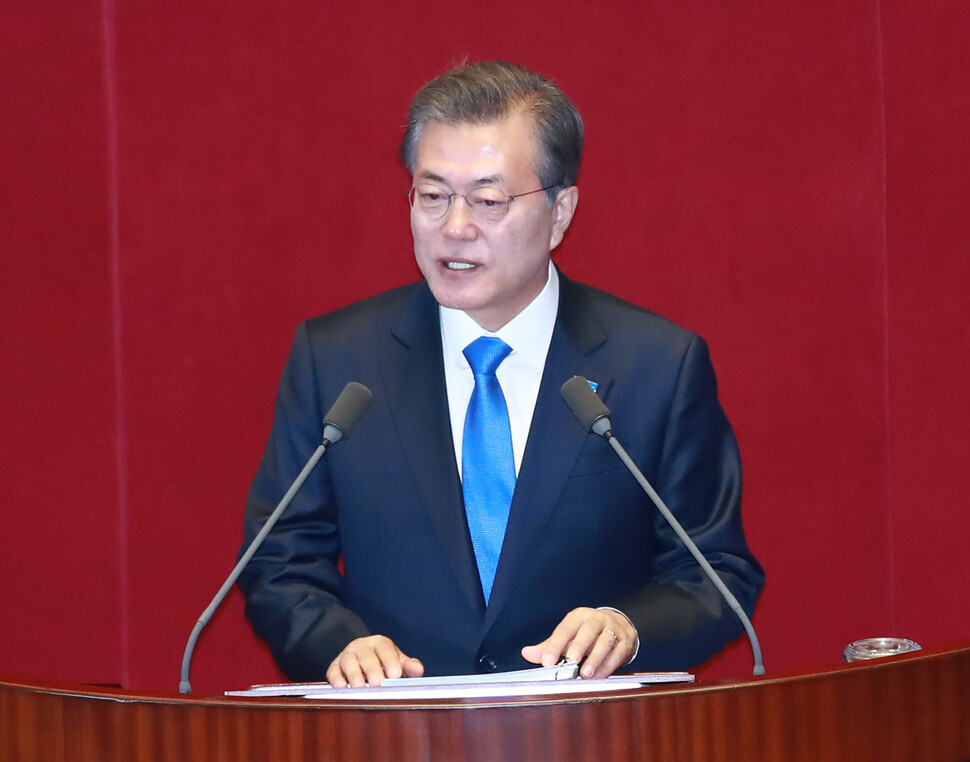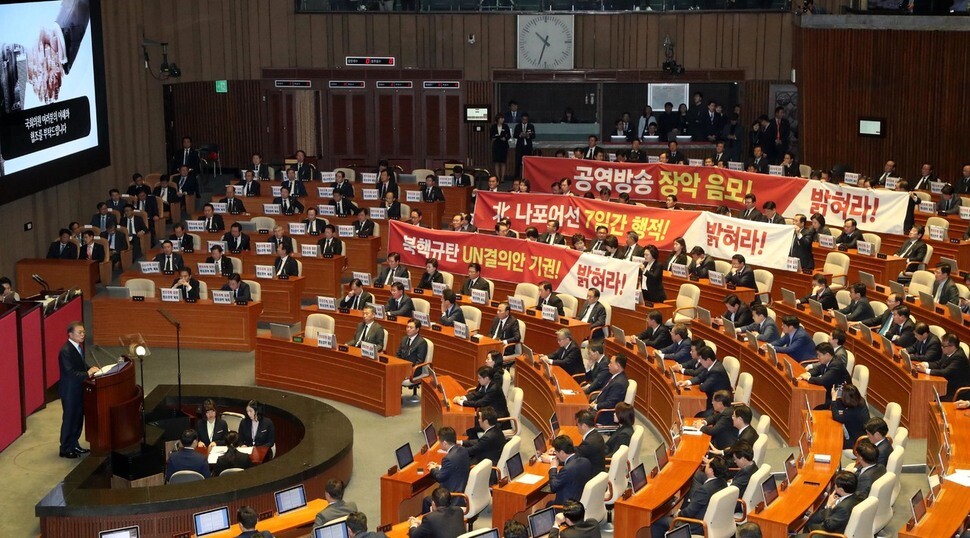hankyoreh
Links to other country sites 다른 나라 사이트 링크
President Moon lays out five principles for a peaceful Korean Peninsula

During his address proposing next year’s budget plan at the National Assembly on Nov. 1, South Korean President Moon Jae-in unveiled five principles for achieving peace on the Korean Peninsula. These principles highlight a selection of the key elements from Moon’s congratulatory address on Liberation Day in August and his speech before the Korber Foundation in Germany (the Berlin declaration) in July, in which he called for South Korea to play a leading role in establishing peace on the Korean Peninsula. The Moon administration appears to have nailed down its policy for the Korean Peninsula.
“The Korean Peninsula is the place where the Korean people live and will continue to do so. It must be kept safe and peaceful, and making sure this happens is a responsibility vested in the President by the Constitution,” Moon declared in his speech.
“The new Administration was launched amidst the gravest security environment we have seen in a long time. The Government is working to stabilize the management of the current situation and, at the same time, ultimately ensure peace on the Korean Peninsula,” he said, as he laid out his five principles.
The first principle is “establishing peace on the Korean Peninsula.”
“Our top priority is to maintain peace on the Korean Peninsula. Thus, armed conflict must be avoided under any circumstance. No military action on the Korean Peninsula shall be taken without prior consent of the Republic of Korea,” he asserted. This appears to be aimed at the US, which continues to toy with the possibility of using the “military option” against North Korea. Significantly, Moon delivered this message on the very podium in the National Assembly where US President Donald Trump will deliver his own address on Nov. 8, exactly one week later. Along with reflecting the fact that concerns remain about a military clash between North Korea and the US, Moon appears to have set the tone for his administration’s Korean Peninsula policy by placing this first among his five principles.
Next, Moon reaffirmed the principle of the “denuclearization of the Korean Peninsula.”
“The Joint Declaration on the Denuclearization of the Korean Peninsula, signed by both South and North Korea, makes it impossible to accept or acknowledge North Korea as a nuclear power. South Korea will not develop or possess nuclear arms, either,” he added. This was a blunt dismissal of the arguments advanced by South Korea’s conservative establishment following North Korea’s sixth nuclear test to have the US redeploy tactical nuclear weapons or develop South Korea’s own nuclear arsenal.
The third principle elucidated by Moon was for South Korea to “take [a] primary role in resolving the inter-Korean issue.” This is a position that Moon has underlined since he became a candidate for president. “The destiny of the Korean nation must be determined by Koreans. The unfortunate past in which our destiny was determined against our will, such as colonial rule and national division, must never be allowed to recur,” he stressed.
After this, Moon proposed the principle of “a peaceful resolution of the North Korean nuclear issue.” He reconfirmed that the sanctions and pressure against North Korea imposed by the international community (including the UN Security Council) under the lead of the US are “the means to guide the North toward making the right choice and coming to the negotiating table.”
The fifth principle that Moon espoused was “a stern response to any North Korean provocation.”
To achieve this, Moon promised to “retain overwhelming military superiority,” “a firm ROK-U.S. alliance” and to “work proactively with the international community.” This was tied to a plan to increase spending on national defense. “In a bid to make our armed forces stronger and to equip them with self-reliant national defense capabilities, the budget for national defense has been increased by 6.9 percent, the highest rise since 2009,. In particular, the budget for the enhancement of defense capabilities saw a marked 10.5 percent increase,” he said.
“To protect the people from the North Korean threat, the establishment of the three-pillar system will be completed at an early stage,” Moon said, referring to the Kill Chain, Korea Air and Missile Defense (KAMD), and Korea Massive Punishment and Retaliation (KMPR). This reflects Moon’s consistent emphasis on “peace based on strength,” which is not in line with the basic historical position of South Korea’s liberals (currently called the Democratic Party) of achieving peace through improving inter-Korean relations.

By Kim Ji-eun, staff reporter
Please direct questions or comments to [english@hani.co.kr]

Editorial・opinion
![[Column] Park Geun-hye déjà vu in Yoon Suk-yeol [Column] Park Geun-hye déjà vu in Yoon Suk-yeol](https://flexible.img.hani.co.kr/flexible/normal/500/300/imgdb/original/2024/0424/651713945113788.jpg) [Column] Park Geun-hye déjà vu in Yoon Suk-yeol
[Column] Park Geun-hye déjà vu in Yoon Suk-yeol![[Editorial] New weight of N. Korea’s nuclear threats makes dialogue all the more urgent [Editorial] New weight of N. Korea’s nuclear threats makes dialogue all the more urgent](https://flexible.img.hani.co.kr/flexible/normal/500/300/imgdb/original/2024/0424/7317139454662664.jpg) [Editorial] New weight of N. Korea’s nuclear threats makes dialogue all the more urgent
[Editorial] New weight of N. Korea’s nuclear threats makes dialogue all the more urgent- [Guest essay] The real reason Korea’s new right wants to dub Rhee a founding father
- [Column] ‘Choson’: Is it time we start referring to N. Korea in its own terms?
- [Editorial] Japan’s rewriting of history with Korea has gone too far
- [Column] The president’s questionable capacity for dialogue
- [Column] Are chaebol firms just pizza pies for families to divvy up as they please?
- [Column] Has Korea, too, crossed the Rubicon on China?
- [Correspondent’s column] In Japan’s alliance with US, echoes of its past alliances with UK
- [Editorial] Does Yoon think the Korean public is wrong?
Most viewed articles
- 1‘We must say no’: Seoul defense chief on Korean, USFK involvement in hypothetical Taiwan crisis
- 2N. Korean delegation’s trip to Iran shows how Pyongyang is leveraging ties with Moscow
- 3[Column] Park Geun-hye déjà vu in Yoon Suk-yeol
- 4Amnesty notes ‘erosion’ of freedom of expression in Korea in annual human rights report
- 5‘Weddingflation’ breaks the bank for Korean couples-to-be
- 646% of cases of violence against women in Korea perpetrated by intimate partner, study finds
- 7[Reportage] On US campuses, student risk arrest as they call for divestment from Israel
- 8“Parental care contracts” increasingly common in South Korea
- 9[Interview] Dear Korean men, It’s OK to admit you’re not always strong
- 10Korean government’s compromise plan for medical reform swiftly rejected by doctors